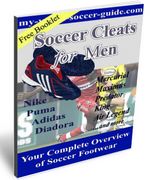Cleats, Turf and Indoor |
|||||||||||||
2. Outdoor shoes (Cleats)
3. Turf shoes
Every soccer shoe is built from three components (so is any shoe...I guess):
Upper and midsole are the same for all types (pictures below). Of course there are many different styles, designs, materials and technologies used in different models by different manufacturers (leather, synthetic materials, special rubber, plastic etc.) but basically they all have one thing in common: to provide comfort, support and great feel for the ball.
The major, actually the only difference between these types of soccer shoes is their outsole (the bottom of the shoe). Every type is designed to perform under certain field conditions.
Click on images for larger views

 |

 |

 |
| Indoor Shoes | Outdoor Shoes (Cleats) | Turf Shoes |
Indoor Soccer Shoes
This type is designed for playing indoor soccer on indoor courts and fields (like gym or indoor soccer facilities). They are actually flat-surfaced, low-cut shoes with a slightly harder surface area than a traditional sneaker.
Turf Soccer Shoes
These shoes contain various raised patterns on the bottom, for use on harder outdoor surfaces and on artificial turf.
Outdoor Soccer Shoes (Cleats)
Soccer cleats are intended for playing outdoors. One of the most important purposes of soccer cleats is to provide a player with enough amount of traction preventing him/her from slipping and giving him an opportunity to turn, stop and accelerate with ease.
In order to achieve it, soccer cleats outsole has several hard rubber, plastic or metal studs that sink into the surface providing a good grip. But the studs have to be long enough to offer good traction and short enough not to cause discomfort from applying too much pressure on the feet.
 |
 |

|
 |
As we all know soccer fields surfaces might vary. From hard dirt ones through softer yellow-green grass here and there to those nice and soft with full natural turf pitches. We can't forget about the weather factor. The rain can change field conditions dramatically.
Therefore soccer cleats come with different stud types made accordingly for certain field conditions.
One way of grouping soccer cleats is by the type of studs they have:
Molded studs and
Replaceable studs.
The other way of classifying cleats is by various field conditions they are proper for:
- Hard Ground (HG) - for playing on hard fields.
These cleats have short studs, usually evenly distributed through the entire outsole. Soccer cleats with circular, hard rubber studs are the most effective for hard surfaces. They provide you with enough amount of traction but at the same time, they don't apply too much pressure on your feet causing discomfort when your cleats are unable to dig into hard ground. - Firm Ground (FG) - for playing on firm fields.
These are the most common types of soccer cleats (at least in the U.S.). Why? Because most of soccer fields youth soccer players play on are firm, which means they are not too hard but not too soft either. Since not everyone can afford to own couple or even few pairs, these soccer cleats became very universal. - Soft Ground (SG) - for playing on soft fields.
Almost all soccer cleats for soft pitches have detachable studs or stud's tips. Like molded, these replaceable studs could be a circular or blade shape. They come in different lengths, so you can adjust your soccer shoes based on the condition of the field. Having said that, you can use the shortest possible studs for firm ground (but real firm or how I call it "not so soft ground").
Shopping
Soccer Brands
Soccer Info
Coaching Soccer
Web Site Info
| Home |
Sitemap |
Contact Me |
Blog |
Privacy Policy |
Disclaimer |
Copyright © 2005-2013 My-Youth-Soccer-Guide.com All rights reserved.








